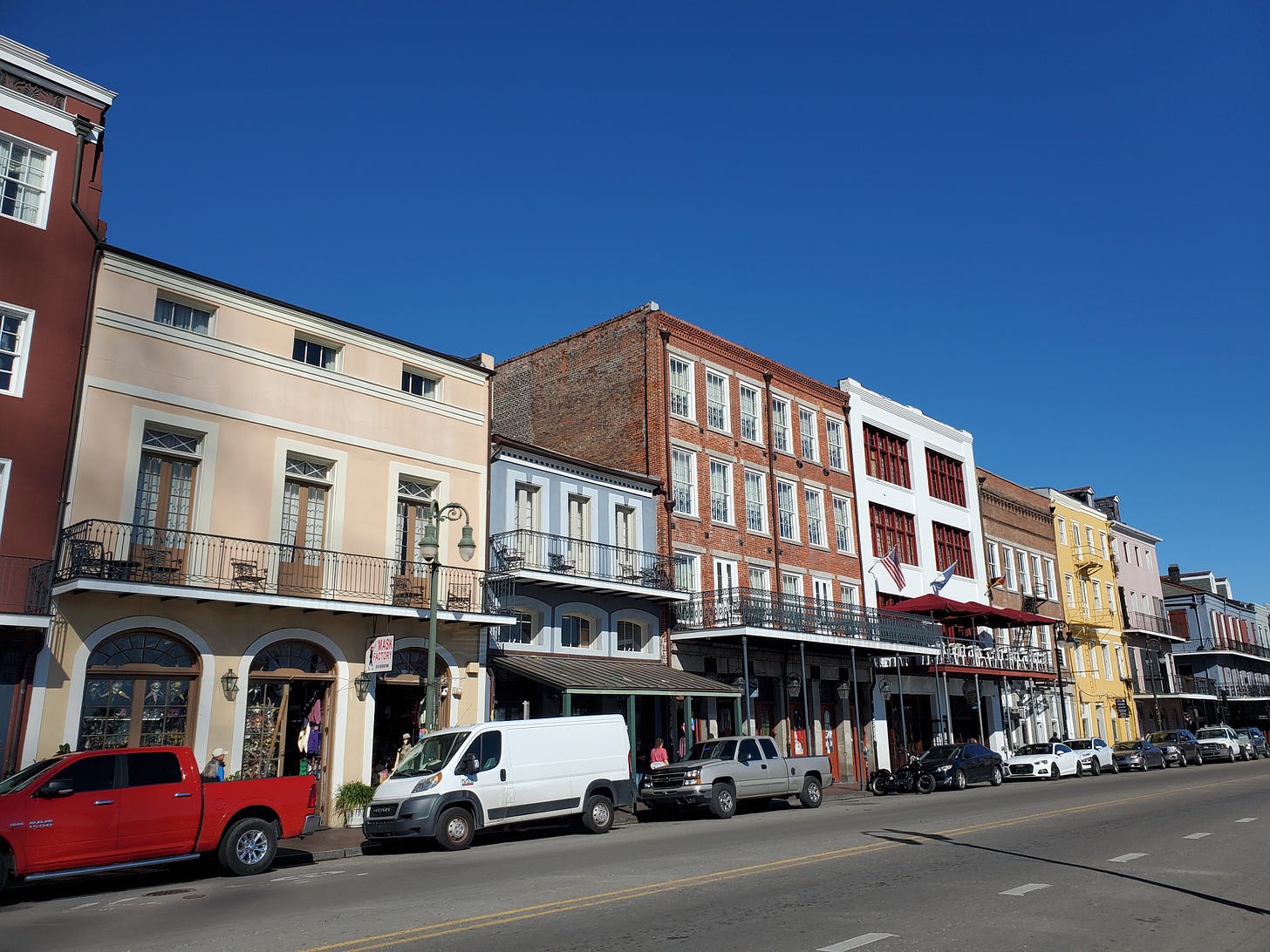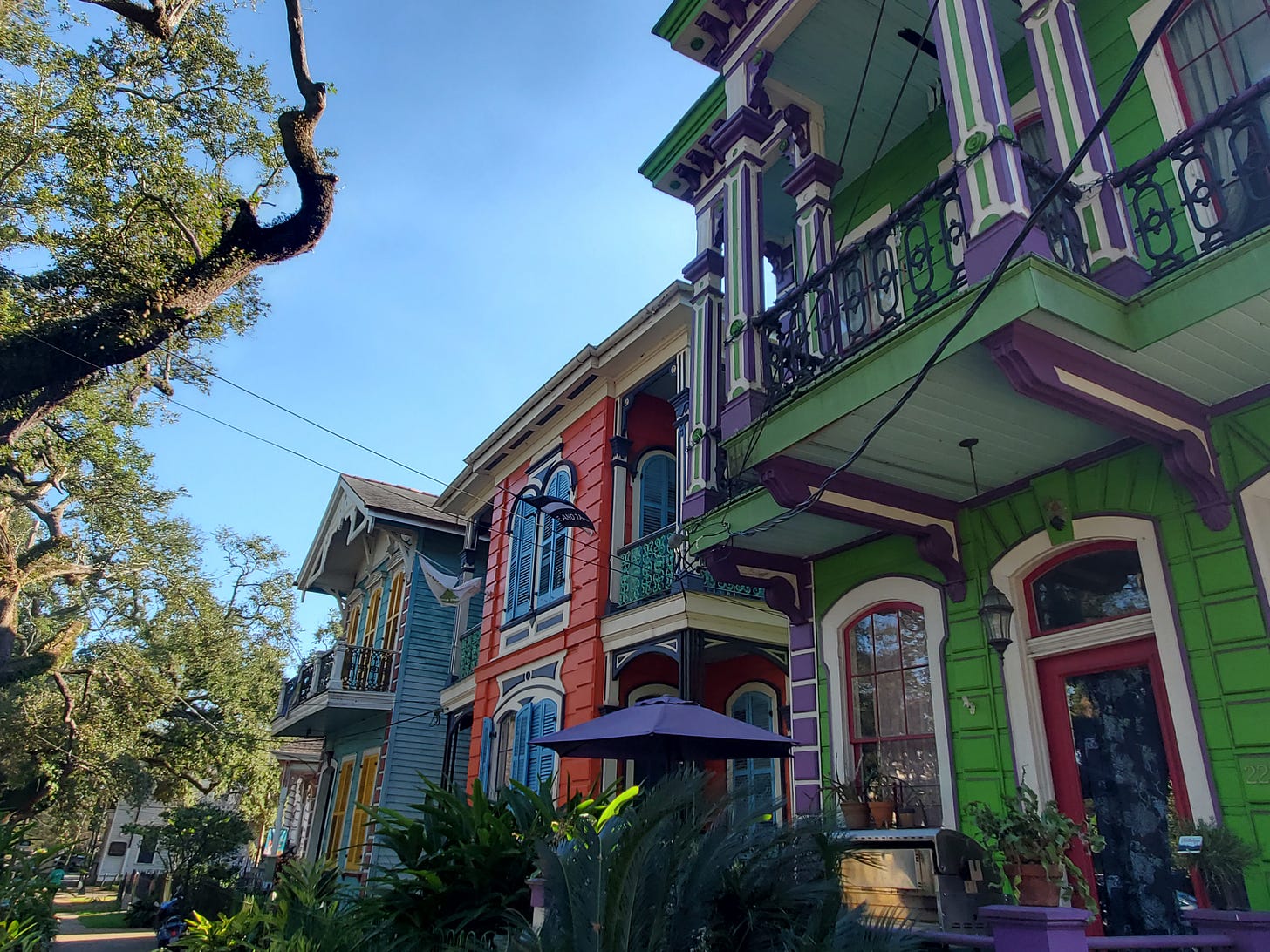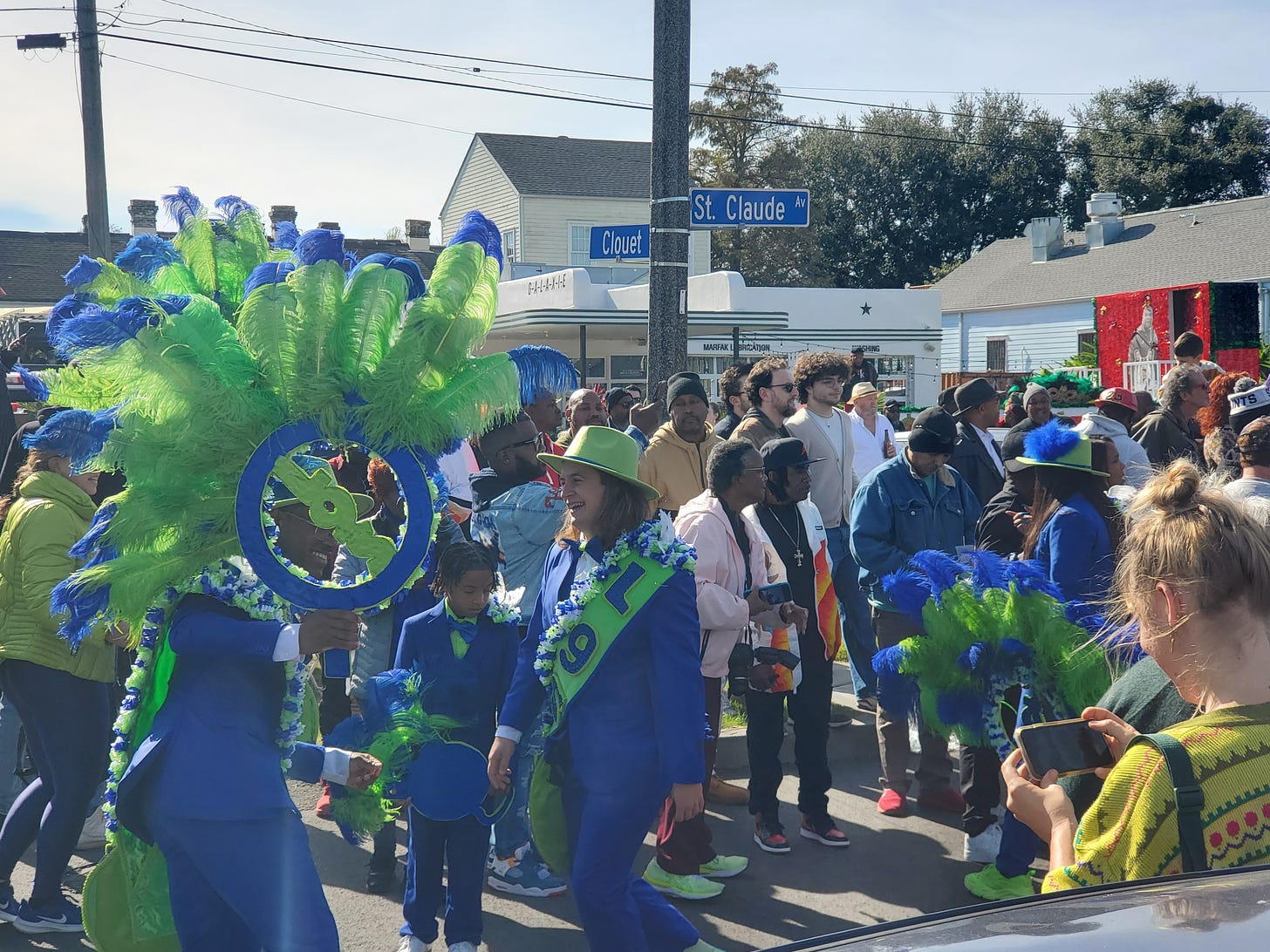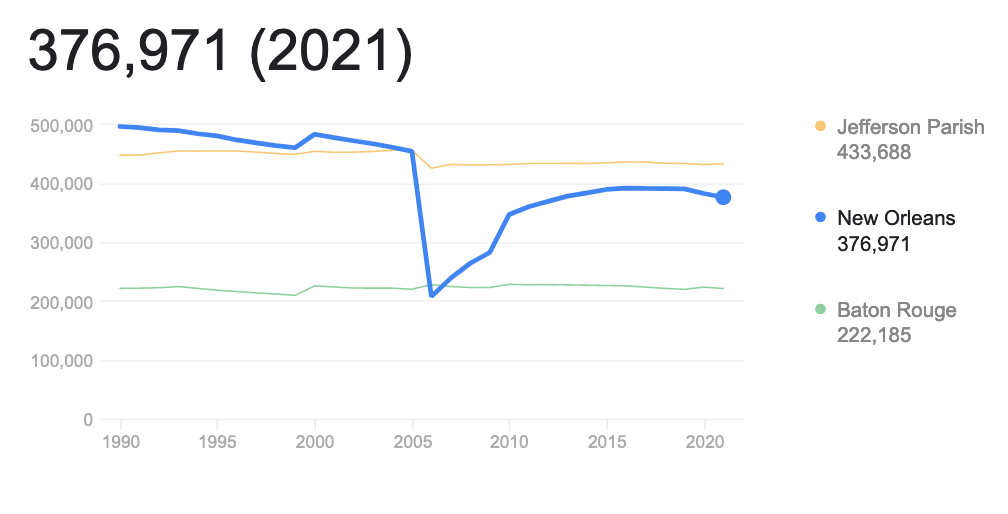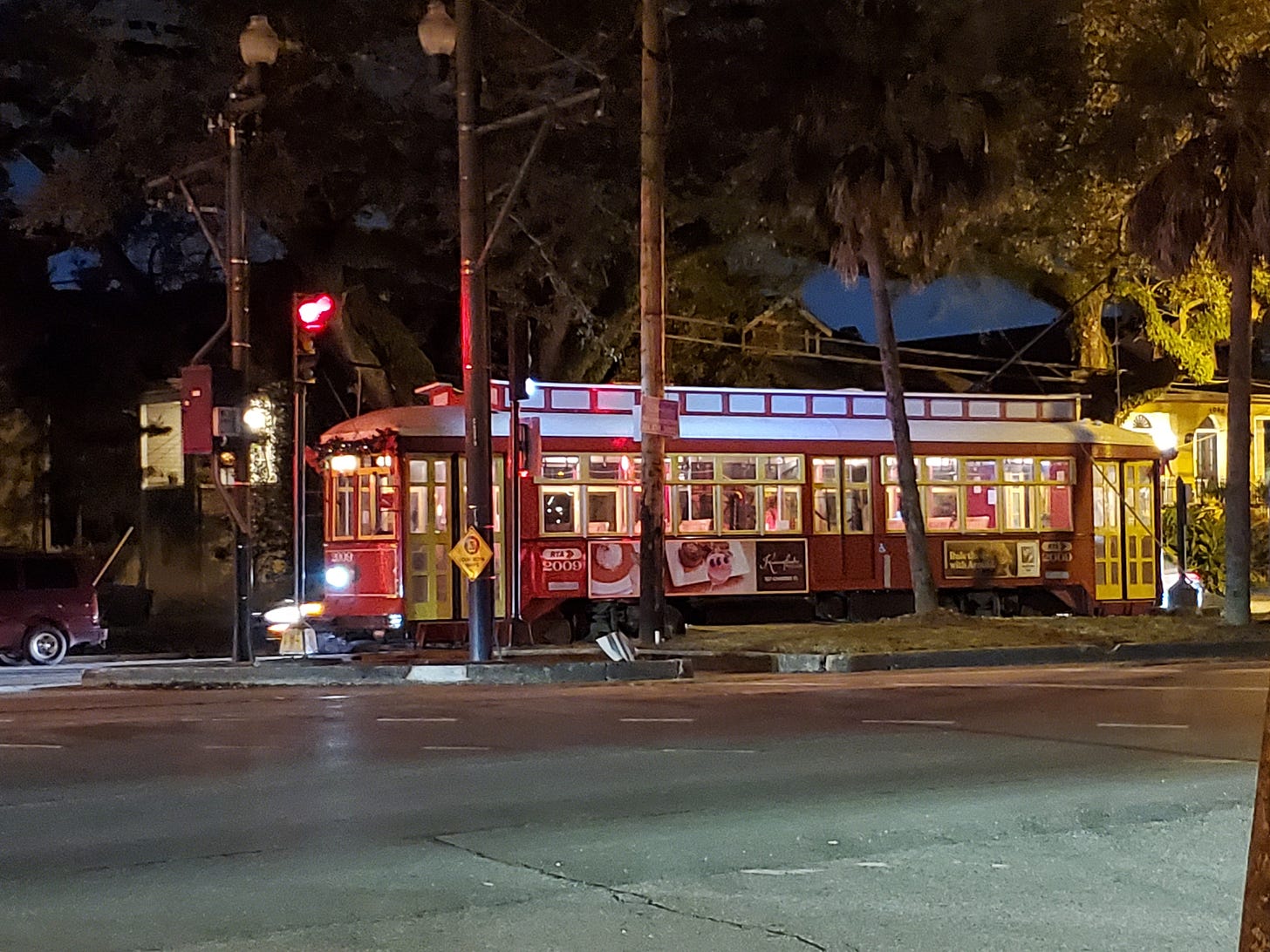An Urbanist Goes to New Orleans
Naturally, New Orleans is an ideal place for an urbanist. If there were any city in the South that is old enough to be fairly walkable, it’s New Orleans. While there are competitors like Austin, TX, with its new age urbanism, there’s a level of half-assed and insufficient-ness to new urbanism that older cities lack.
Traffic
Something that immediately stuck out to me was how dangerously inconsiderate drivers were in New Orleans. When attempting to cross my first street in New Orleans by waiting at a crosswalk, I was confused why literally no car stopped or even slowed down after 2 minutes of waiting.
Apparently the custom of driver sees pedestrian at crosswalk so driver stops and yields is a West Coast thing. Not only did they not stop as I waited, but they didn’t even stop while I was walking in the crosswalk. Instead, drivers did this dangerous maneuver of shifting to the lane behind me at full speed. Without fail in my entire week of being in New Orleans, not a single driver stopped to let me walk the crosswalk unless a traffic light was red.
I struggled to comprehend how impatient you’d have to be to threaten a pedestrian’s life by not even yielding to them while in the crosswalk. You’d be failed for doing this during a DMV drivers test. The driver must make a trajectory-based calculation while going full speed and changing lanes to dodge me — which in turn ensured I sped my ass through the crosswalk because stopping or slowing down midway would ensure I would get hit. This occurred every single time I crossed a crosswalk in New Orleans without fail.
But it goes without saying that a lot of people in New Orleans can go their whole lives without ever being a pedestrian. Which explains the poor quality of sidewalks particularly away from the French Quarter and of course non-existent sidewalks in the New Orleans suburbs. I was admittedly amazed at the sight of commuter bus stops alongside roads with drain ditches instead of a sidewalk behind them. I struggled to understand how outside the urban redevelopment-era financial district around Canal Street where sidewalks were wide that anywhere else in the city was accessible.
Of course, the excuse given by city officials and politicians for bad road conditions and even worse sidewalk conditions is the constant flooding. After all, New Orleans is technically sinking and thus the pavement is pummeled which must be pumped out the city’s municipal pumping system. But this obviously isn’t the case, as paving was good in the business district and the French Quarter — even with its old timey stone walkways — but very poor outside the core, particularly in the Ninth Ward.
Housing
As far as housing goes, New Orleans is obviously a lot more affordable than the Bay Area, but that doesn’t mean much. Anywhere I go home prices will seem better. While I saw homeless encampments underneath certain freeways, it was nowhere to the extent now commonplace under the freeways of Oakland or Los Angeles. Orleans and Jefferson parish (a Louisiana version of a county) counted 555 homeless persons compared to just San Francisco’s official tally of 7,754. Even relative to wages, housing is more affordable here than California, but homelessness is still a national problem.
The city’s urbanism is quite wonderful with an abundance of pretty duplexes and triplexes in the French Quarter and throughout the numerous wards. I was especially impressed with the beautiful Victorian homes of the Garden District and the streetcar suburbs of City Park. The city appears to be undergoing a mass preservation campaign, as beautiful houses that have fallen into disrepair had signs on them labeling them as under restoration.
Equally noticeable was the abundance of vacant properties which reflects in the Census at 18.4% of all housing supply. Half of the vacant properties are off-the-market and 30% of the vacancies have remained vacant for more than two years, which shows New Orleans’s housing situation is closer to Detroit than the high demand metros. It didn’t seem to matter whether in the tourist heavy French Quarter or the more working class Seventh Ward — vacant buildings with boarded up windows were everywhere. According to some talk from the locals, the vacancies in French Quarter were the product of AirBnBs while outside of it were derelict properties whose owners were not redeveloping or maintaining.
Population
New Orleans appears to have changed significantly in the 2010s, in ways that are astonishing even to locals. One New Orleans local who had grown up there — a Black man perhaps in his late 30s — described the city’s changes to me. He said starting around the early 2010s the city’s population had really begun to change and white people had moved into the city en-masse. He said all the old projects had been cleaned up with new buildings and much of the gang violence he grew up with had disappeared — save for a few wannabe kids.
He didn’t say it was good or bad but the tone in his voice seemed truly amazed, if not supportive, at the demographic change that occurred in the city. Coming from the Oakland area, it didn’t initially seem good to brag about the influx of whites as that usually was an indicator of gentrification. But the g-word never really came up, although I was only there for a week.
A lot of the Black residents I spoke to took pride in New Orleans’s post-Katrina recovery. The city had consistently dropped in population since the 1960s with decade after decade decline fueled by white flight. Then came Hurricane Katrina, which sent tens of thousands of Black New Orleans to metropolises all over the country as the population dropped to its lowest point. When I mentioned that I had come to New Orleans after years of encouragement by Katrina-era Black transplants in Oakland, it had gotten under a few residents’ skin a bit that they had moved away.
There was this pride that they had “weathered the storm” and stuck through it. Not only that, but the Black population of the city were not all born and raised locals, as many had come to New Orleans from all over the South and Midwest. The proof in their resiliency and faith in New Orleans was this cultured, pleasant city whose uncanny population rebound proved its popularity.
Unfortunately, the old binary phenomenon of White Flight/Black Influx and White Influx/Black Displacement may be at play in New Orleans. The Black population in the Orleans Parish altogether only increased by about 1,000 over the last 10 years while the white population increased short of 17,000. It’s not just whites either, as Latinos increased in the parish by about 13,000.
According to a study conducted by the National Community Reinvestment Coalition, New Orleans was the fifth most gentrifying city in the nation. Their methodology measured rent, income and education attainment changes in Census tracts and the results in New Orleans show the areas becoming wealthier. Their methodology did not measure race, however, which would’ve been informative to see what broader issues are at play. I could map out the racial changes in New Orleans, but I’d have to throw that in the ethnography GIS queue I already am working on.
Thousands of Black people are moving into Baton Rouge and nearby Jefferson Parish, coinciding with the tremendous white decline in those areas, suggesting mass migration to New Orleans probably hints at gentrification and displacement.
I will admit coming from California I was not accustomed to seeing such social integration as I had seen in French Quarter, with crowds equally Black and White partying throughout the night. But segregation is played a little differently than home: not from one city to another as is the case in California but at a hyper-local block level. Walking from one neighborhood to another, or one ward to another, the area would jump back and forth between white and black constantly.
I had also been impressed with the level of Black-owned businesses I had see when first arriving. Again, in the Bay Area, a popular Black owned business is an anomaly. But in New Orleans, it seemed like a lot of cafes, shops and stores were Black-owned which gave me pride in the mass ownership of commerce by my people.
But yet another underside was that much of the white owned businesses were deeply segregated by staff too. Many of the lowest paid workers and tourist-based service workers were often Black while managerial workers and higher paid staff were white, according to my conversations with locals. In Louisiana the minimum wage was a measly $7.25 an hour, and much of the waiters and chauffeurs received the federal tipped minimum wage of $2.13.
32% of Black New Orleans households are in poverty compared to 10% of white households.
Transportation
Like all agencies around the country, the RTA which serves New Orleans suffers from an operator shortage, and so I got burned by a few ghost buses here and there, but using the bus was easy for a first timer. The buses were also adequate insofar as speed, and traffic didn’t hold them up by much if at all. The bus system had a help app which tracked buses in real time and paid for rides digitally.
The historic streetcar was nice and grade separated mostly from traffic which actually made it superior to the one in San Francisco. Like most American cities, New Orleans was once a streetcar-first town whose private transit agency dismantled most of the lines until public transit took over. The RTA’s streetcar network however is more than just performative and reaches a decent amount of neighborhoods throughout New Orleans that are key for tourists and some locals.
Of course, realistically, New Orleans transit system overall wasn’t high quality. Grading on a Southern curve its among the best in the South but nationally it was average and much of it needed more investment. The bus stops were often barren without seating or shelter which was almost exclusively afforded to the streetcar system heavy with its tourists. Most bus stops I found in residential New Orleans were along dilapidated corners without shelters or seats, which seems truly baffling in a city known for its storms.
The RTA’s bus fleet seemed quite out of date for a major city. They blew an excessive amount of exhaust and fumes whenever the drivers hit the gas, leaving a huge cloud of smoke as if a bomb had gone off. In comparison, many of the California bus systems have transitioned to electric batteries or fuel cell low and zero emission vehicles thanks to state funding. Lousiana’s state government clearly doesn’t have the same priorities.
An undeniable difference in ridership demographics was very apparent when riding the tourist heavy streetcars which were majority white riders versus the almost exclusively locally-used bus system in which everyone was Black. This isn’t uncommon, as bus travel is coded for poor people while train travel, even if doing the same thing as a bus such as a streetcar, is usually white and wealthier travelers. But considering how limited the streetcar in reach compared to the superior and fairly pleasant the bus system, I couldn’t help but think what a loss it was for those tourists unwilling to simply tap their transit cards on the bus.
Conclusion
New Orleans is the most cultured city in the United States, and it deserves an urbanist analysis often deprived of it compared to more popular metros. The city is undergoing a debate as to whether more money should be invested in pumping systems and better levees, since the city is always sinking, or if it should go the way of Atlantis and strategically retreat populations out of it. Nathan J. Robinson, editor of the left-wing magazine Current Affairs and New Orleans resident explained it to me like this.
The neighborhoods at the lowest elevation in New Orleans are the Black neighborhoods and predominantly Black wards. The lowest elevation neighborhoods are most prone to flooding. When people argue New Orleans should be left to sink, what they’re arguing is to destroy those Black neighborhoods first and foremost.
The federal government should invest heavily into the future of New Orleans and its wards with modern pump systems, massage drainage systems, better levees, a rapid transit system and an accessibility makeover. To lose New Orleans would be to lose the jewel of the South and all the wonderful people that made the city what it is.



